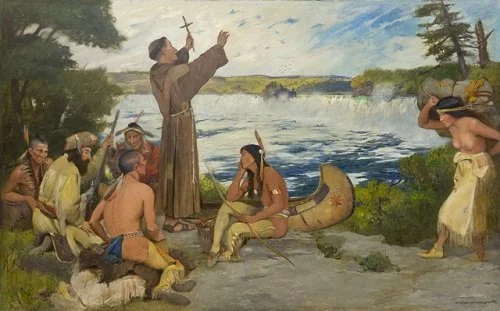The Man Who Claimed to See Niagara First — Father Hennepin and the Falls That Made Him a Legend
Mural of Hennepin at the Niagara Power Authority.
“Betwixt the Lake Ontario and Erie, there is a vast and prodigious Cadence of Water… insomuch that the Universe does not afford its parallel.”
— Father Louis Hennepin, 1683
The Man Who Claimed to See Niagara First—And the Falls That Made Him a Legend
If you’ve ever been to Minnesota and walked across Hennepin Avenue in Minneapolis or paused at Father Hennepin Bluff Park, you’ve seen the echo of a man whose life was anything but quiet. But to understand Father Louis Hennepin, you need to travel back—through snow-drifted forests and across the roaring Great Lakes—to Niagara Falls, where his legend was born.
Long before he became a Minnesota namesake, Hennepin may have been the first European to witness—and write about—Niagara Falls. He didn’t just see the falls—he mythologized them. And in doing so, he transformed a thundering stretch of water into a cornerstone of continental identity.
“This Horrible Precipice”: A Winter Walk into History
In December 1678, Hennepin was part of an expedition led by René Robert Cavelier, Sieur de La Salle, seeking a passage west. As they neared the Niagara region, they could hear it before they saw it—a roar like thunder carried on the wind. On December 8, Native guides led Hennepin through fresh snow and tangled forest to the brink of the unknown.
“Multiply that sense of awe a thousand times,” wrote Jeff Z. Klein for Buffalo Toronto Public Media, “and we can only begin to know what Father Louis Hennepin felt in the winter of 1678–79 when he stumbled through the woods and stood at the brink of Niagara.”
And then he wrote it down.
In 1683, Hennepin published Description de la Louisiane, giving Europe its first vivid—and dramatically exaggerated—description of the falls:
“Betwixt the Lake Ontario and Erie, there is a vast and prodigious Cadence of Water… insomuch that the Universe does not afford its parallel.”
“The Waters… do foam and boil after the most hideous manner imaginable, making an outrageous Noise, more terrible than that of Thunder… their dismal roaring may be heard more than Fifteen Leagues off.”
He was wrong about the height—claiming 600 feet (more than double the actual drop). But he wasn’t wrong about the awe. The falls he saw flowed unimpeded—with more than two million gallons per second crashing over the edge, free of hydroelectric diversions or industrial interference.
George Catlin’s circa‑1847 painting, depicting Hennepin preaching to Dakota tribe members at St. Anthony Falls on the Mississippi—highlighting another key episode of his travels
The Falls Before Hennepin
But was he really the first?
That’s harder to say.
Earlier missionaries, like Father Joseph De La Roche Daillon (1626) and Jesuit Fathers Jean de Brébeuf and Joseph Chaumonot, traveled nearby but left no mention of the falls. A mapmaker named Ducreux marked them on a map in 1660—but offered no written description.
So while others may have passed near, Hennepin was the first European to both see and describe Niagara Falls in print. And through his words, he made them known to the world.
From Niagara to the Mississippi: A Life of Spectacle
Hennepin’s adventures didn’t end at Niagara.
As Michael Rainville Jr. recounts in Mill City Times, Hennepin later explored the Mississippi River, where he was captured by the Dakota near present-day Lake Pepin and taken north to Mille Lacs. Eventually rescued, he journeyed downriver and became the first European to document St. Anthony Falls, naming them after St. Anthony of Padua.
He called them the “Niagara of the West.”
And just like that, Hennepin linked two great rivers—and two iconic cities—Minneapolis and Niagara Falls—through a shared spectacle of natural power.
Man, Missionary, Mythmaker
Back in Europe, Hennepin published three books about his travels. He made waves—and enemies. King Louis XIVthreatened to arrest him if he returned to New France. Hennepin accused La Salle of hoarding discoveries and claimed more glory than his companions granted.
Still, his words endured.
As he once wrote, “Sieur de La Salle wanted all the glory… to prevent them from publishing what they had seen.”
But it was Hennepin who published. And in doing so, he became unforgettable.
The Name Lives On
Today, Hennepin County, Father Hennepin State Park, and Hennepin Avenue in Minneapolis all bear his name. In Lewiston, NY, a mural by Thomas Hart Benton at the Niagara Power Project immortalizes Hennepin’s moment of awe.
Across the river, on Goat Island, a scenic overlook called Hennepin View still marks the spot near where he first saw the falls. It is a quiet tribute—unassuming, yet profound—a plaque near the edge of the same roaring water he once called:
“A prodigious Cadence of Water… which the Universe does not afford its parallel.”
Granger’s dramatic 19th‑century painting showing Hennepin by a canoe at the brink of the Falls
Depiction of Hennepin in his canoe.
This 1698 image from London is one of the earliest known illustrations of Niagara Falls.
Basilica St Mary Minneapolis







